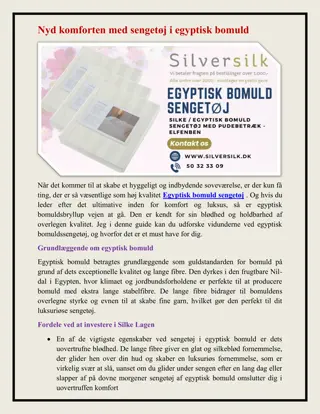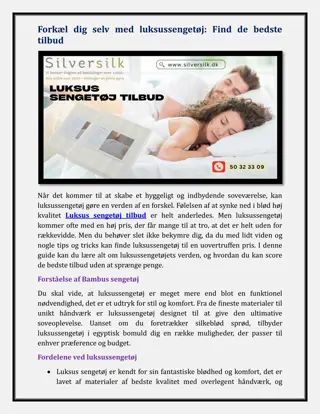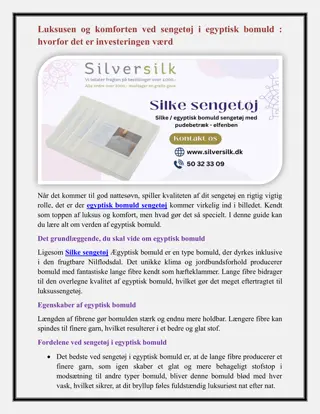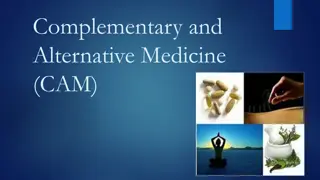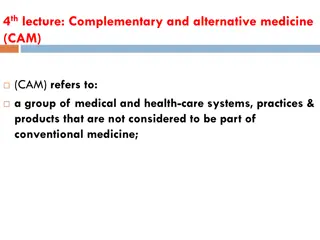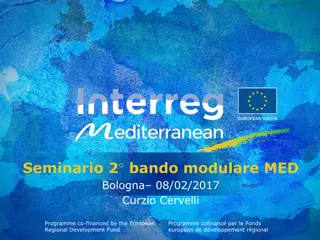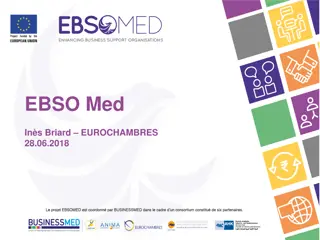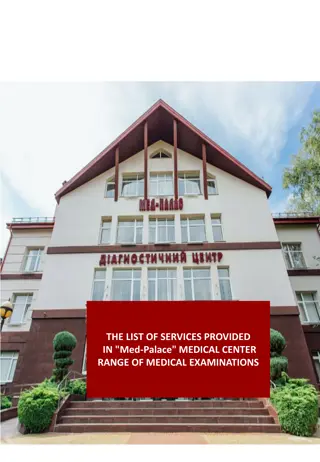
Exploring Traditional and Alternative Medicine in the Philippines
Discover the rich history and current initiatives surrounding traditional and alternative medicine in the Philippines. Learn about the Traditional and Alternative Medicine Act, key principles, and ongoing research and development efforts. Dive into the cultural significance and evolution of traditional healing practices in this insightful exploration.
Download Presentation

Please find below an Image/Link to download the presentation.
The content on the website is provided AS IS for your information and personal use only. It may not be sold, licensed, or shared on other websites without obtaining consent from the author. If you encounter any issues during the download, it is possible that the publisher has removed the file from their server.
You are allowed to download the files provided on this website for personal or commercial use, subject to the condition that they are used lawfully. All files are the property of their respective owners.
The content on the website is provided AS IS for your information and personal use only. It may not be sold, licensed, or shared on other websites without obtaining consent from the author.
E N D
Presentation Transcript
DOH - ALTERNATIVE MEDICINE Samson Santiaguel Santos Tamayo Tobias Tomeldan Verzosa - Viray
INTRODUCTION Traditional medicine Traditional medicine has been practiced since ancient times in every culture throughout the world and has been an integral part of human evolution and development. It covers a wide spectrum of practices and differs from one another even in these modern times where information and advanced science has greatly progressed, traditional medicine still enjoys a large following most especially in rural areas 2
DOH and RA 8423 1992 - Former health secretary and Sen. Juan M. Flavier launched the Traditional and Alternative Medicine Act (TAMA) 1997 Former President, Fidel V. Ramos appreciated the importance of traditional medicine and signed into the law RA 8423. 2004 President Proclamation No. 698, s. 2004 - November as Traditional and Alternative Heath Care (TAHC) month led by the Philippine Institute of Traditional and Alternative Health Care (PITAHC) as a body attached to the DOH. Philippine Research and Development Framework on Traditional and Complementary Medicine (T&CM) 2014 The PITAHC board of trustees approved the institute s 3
Republic Act 8423 SECTION 1: Short Title Traditional and Alternative Medicine Act (TAMA) 1997 Article I. GUIDING PRINCIPLES 4
Republic Act 8423 SECTION 1: Short Title Traditional and Alternative Medicine Act (TAMA) 1997 Article I. GUIDING PRINCIPLES 5
Proclamation No. 698 S. 2004 DECLARING THE MONTH OF NOVEMBER AS TRADITIONAL AND ALTERNATIVE HEALTH MONTH 6
Strategic Plan for CY 2017 - 2022 RESEARCH AND DEVELOPMENT Some Accomplished Researches as of 2018 Descriptive Study of Five (5) Sacred Healing Places in Luzon In Vitro Evaluation of Psidium guajava ethanolic extract against four dominant Leptospira serovars in the Philippines A Randomized, Placebo-Controlled Phase I and Phase II Study to Evaluate the Safety, Tolerability, and Efficacy of Psidium guajava Ointment in Subjects Colonized with Staphylococcus aureus Acute Maternal and Fetal Cardiovascular Responses to Exercise: A Single Blinded Randomized Controlled Trial to Improve Antenatal Surveillance Strategies in Filipino Women Work-related disability Caused by Headache Disorders among Workers in Asia A Survey at Information Technology (IT) Industries in Japan, Republic of Korea, and the Philippines Medical Marijuana in the Philippines: Developing a Research Agenda Evaluation of Safety and Efficacy of Siling Labuyo (Capsicum frutescens) Liniment in the Management of Osteoarthritis 8
Strategic Plan for CY 2017 - 2022 Research activities clusters i. Documentation of our cultural heritage on Philippine traditional medicine ii. Research and development on safety, efficacy/benefit, and quality of natural products iii. Clinical research on safety and efficacy/benefit of T&CM modalities iv. Policy, systems, and standards research v. Socio-cultural research vi. Knowledge management vii. Enabling activities 9
Philippines Common Traditional Philippines Common Traditional Practices/Practitioners Practices/Practitioners The The Manghihilot Manghihilot The The Mangtatawas Mangtatawas Tawas is a popular diagnostic ritual performed by most alternative healers that serves in providing clues as to the nature and cause of the illness Pagtatawas originally derived its name from to its chemical nature - alum, an astringent, crystalline double sulfate of aluminum and potassium and early on, was used exclusively in the diagnostic ritual. alternative context, it s a practice of the craft of 'chiropractic' manipulation and massage for the diagnosis and treatment of musculoligamentous and musculoskeletal ailments Most do not have any formal education or training. Other than a breech birth, in some, that is believed to destine or dispose one to this healing art, most rural hilots achieve their skills through an indigenous hand- me-down education. 10
Philippines Common Traditional Philippines Common Traditional Practices/Practitioners Practices/Practitioners The Albularyo The Albularyo Mostly in RURAL areas They are the general practitioners general practitioners by tradition and chronic economic constraints Primary dispensers Primary dispensers of health care There is usually a history of a healer in the family-line, their healing a continuum of a "calling , calling , the power or ability bestowed by a supernatural being, often, attributed to the Holy Spirit Holy Spirit Lacking in formal education Skills are based on and honed from hand-me-down practices and lore understudy or apprenticeship with a family elder or a local healer family elder or a local healer Faith Healers Faith Healers In the Philippine alternative faith healers belong to a separate category of 'specialization 'specialization. . Uncertain some starts medicos or hilot Healings are way different, but they are attributing their healing power power bestowed bestowed from Holy Holy spirit spirit or or Mother Mother Mary hierarchy of healers, in numbers, albularyo s, as from the Mary the 11
Philippines Common Traditional Philippines Common Traditional Practices/Practitioners Practices/Practitioners The Medico The Medico Occasionally, an albularyo furthers his training, assimilates and adopts new skills and "expertise, merging folkloric therapies with mainstream medicine, incorporating allopathic treatment modalities like acupuncture, injection medications and prescription pharmaceuticals into his practice Usually, there is a period of understudy or assistantship with a traditional healer from whom is gleaned the traditional elements that is eventually merged with the alternative. 12
10 Medicinal Plants in the 10 Medicinal Plants in the Philippines Endorsed by Philippines Endorsed by DOH Reference DOH Reference 13
1.) 1.) Lagundi Lagundi (Vitex negundo L.) (Vitex negundo L.) Lagundi (Vitex negundo L.) It is one of the ten herbal medicines endorsed by the Philippine Department of Health as an effective herbal medicine with proven therapeutic value. Studies have shown that Lagundi can prevent the body s production of leukotrienes, which are released during an asthma attack. Even in Japan, lagundi is becoming recognized as an effective herbal medicine, especially since researches have shown that it contains properties that make it an expectorant and it has been reported to function as a tonic as well. More than that, most of the parts of the lagundi plant have medicinal value.This medicinal plant had recently been commercialized and many pharmaceutical companies are making cough syrups out of it. Common names: Dangla (Ilokano); five-leaved chaste tree, horseshoe vitex Indication: Leaves and flowering tops decoction, syrup, tablets and capsules for coughs, colds, fever and asthma. Found in: in humid places or along water courses, in waste places and mixed open forest Parts used: Leaves and flowering tops Special precautions: Make sure to have the five-leaved varieties, as there are other varieties of lagundi. 14
2.) Ulasimang 2.) Ulasimang- -bato (Peperonia pellucida) (Peperonia pellucida) bato Small herb that grows from 1 to 1 1/2 feet. Pansit-pansitan can be found wild on lightly shaded and damp areas such as nooks, walls, yards and even roofs. Heart shaped leaves, succulent stems with tiny flowers on a spike. When matured, the small fruits bear one seed which fall of the ground and propagate. Popular traditional medication for gout as this herbal plant contains analgesic properties. Most common type of arthritis for Filipinos Gout According to Philippine Rheumatology Association (PRA) Around 1.6M Filipinos are suffering from Gout This herbal medication is starting to become the center of attraction when looking for an alternative to the conventional treatment of gout, like Allopurinol. 15
Common names: Common names: Ulasimang-bato, pansit-pansitan (Tagalog); olasiman-ihalas (Cebu,Bisaya); tangon-tangon (Bikol); peperonia (English) Indications: Indications: Infusion, decoction or salad for gout and rheumatic pains; pounded plant warm poultice for boils and abscesses Found in: Found in: In lowland rain forest, thickets, hedges, waste places, and roadsides. Parts used: Parts used: aerial plant parts Special precautions: Special precautions: Avoid using with other pain relievers, diuretics 16
Guava (Psidium guajava L.) 3.) Guava (Psidium guajava L.) Bayabas or guava is a tropical plant, which is locally known for its edible fruit. In the backyards of Filipino homes in the country, this plant is commonly seen, and grown because of its many uses as fruit and as traditional remedy to treat various ailments. As shown by many research studies, almost all of the parts of this plant have medicinal qualities and value, and thus, making it as one of the most popular therapeutic plants in the Philippines Common names: Guava, bayabas (Tagalog); guyabas (Iloko); Guava (English). Indications: anti-diarrheal and antiseptic Found in:Common in the Philippines Parts used:Leaves,fruits Special precautions:Eating too much guava fruit may cause constipation 17
Bawang (Alium sativum L.) 4.)Bawang (Alium sativum L.) This herb is one of the most widely used herbal medicines in the Philippines and can also be found commonly in the kitchen of Filipino households as it is used to spice up food preparations. The Philippines bawang or garlic variety is more pungent than the imported ones. Its medicinal properties have been known for a long time and have been especially proven during World War II when it was used to treat wounds and infections of soldiers.Garlic antibacterial compound known as allicin, saved many lives of the soldiers as this property prevented the wounds from being infected and developing into gangrene at a later stage by extracting the juice of bawang or garlic and applying to the wounds. Common names: Ajos (Bisaya); garlic Indications: Fresh cloves, capsules for lowering blood cholesterol levels; antiseptic. Found in: cultivated all over the world. Probably originated from Central Asia Parts used: Leaves and bulbs (cloves) Special precautions: Avoid taking with medicines for lowering blood sugar, and medicines for thinning blood. Dosage must not exceed 6-8 cooked cloves a day. Stomach ulcer may develop if garlic is eaten raw 18
5.) Yerba Buena (Clinopodium douglasii) Yerba Buena has been consumed for centuries as tea and herbal medicine as a pain reliever(analgesic). Native American Indians used it even before the white men colonized the Americas. Today, this folk medicine s efficacy has been validated by scientific research. In the Philippines, Yerba Buena is one of the 10 herbs endorsed by the Department of Health(DOH) as an effective alternative medicine for aches and pains. Common name: Peppermint Indications and preparations: for pain, cough, colds, nausea, dizziness, and pruritus Parts utilized: leaves, sap of plant Uses & Preparation: Pain (headache, stomachache) Boil chopped leaves in 2 glasses of water for 15 minutes. Divide decoction into 2 parts, drink one part every 3 hours. Rheumatism, arthritis and headache Crush the fresh leaves and squeeze sap. Massage sap on painful parts with eucalyptus Cough & Cold Soak 10 fresh leaves in a glass of hot water, drink as tea. (expectorant) Swollen gums Steep 6 g. of fresh plant in a glass of boiling water for 30 minutes. Use as a gargle solution Toothache Cut fresh plant and squeeze sap. Soak a piece of cotton in the sap and insert this in aching tooth cavity Gas pain Soak a handful of leaves in a lass of boiling water. Drink infusion. Nausea & Fainting Crush leaves and apply at nostrils of patients Insect bites Crush leaves and apply juice on affected area or pound leaves until like a paste, rub on affected area Pruritis Boil plant alone or with eucalyptus in water. Use decoction as a wash on affected area. Yerba Buena (Clinopodium douglasii) 19
Sambong (Blumea balsamifera L. DC) 6.) Sambong (Blumea balsamifera L. DC) Sambong is an amazing medical plant. Coming from the family of Compositae, it goes by several names locally. It is known in the Visayas as bukadkad and as subsud in ilocos. This plant possesses a multitude of properties that make it worthy of the DOH approval. Common names: Sambong (Tagalog); lakad-bulan (Bikol); Ngai camphor (English) Indications: Diuretic in hypertension; dissolves kidney stones Found in: In roadsides, fields, lowland and mountainous regions Parts used: Leaves and flowering tops Special precautions: Avoid using with other diuretics. When taking diuretics, eat at least one banana a day. 21
Akapulko (Cassia alata L.) 7.) Akapulko (Cassia alata L.) Akapulko is a shrub found throughout the Philippines. It is known under various names in different regions in the country. Common names: Katanda (Tagalog); andadasi (Ilokano);palochina (Bisaya); ringworm bush,seven golden candlesticks, bayabas-bayabasan Found in: Abundantly naturalized in South East Asia, and occasionally planted throughout the region for medicinal and ornamental purposes Parts used: Leaves Preparation: Anti-fungal (tinea flava, ringworm, athlete s foot and scabies) Fresh, matured leaves are pounded. Apply soap to the affected area 1-2 times a day. 22
Niyog- Niyogan (Quisqualis Indica L.) 8.) Niyog- Niyogan (Quisqualis Indica L.) is a vine known as "Chinese honey suckle". It is effective in the elimination of intestinal worms, particularly the Ascaris and Trichina. Only the dried matured seeds are medicinal -crack and ingest the dried seeds two hours after eating (5 to 7 seeds for children & 8 to 10 seeds for adults). If one dose does not eliminate the worms, wait a week before repeating the dose. Common names: Tartaraok (Tagalog); balitadham (Bisaya); Rangoon creeper, Chinese honeysuckle, liane vermifuge. Indications: Fruit (kernel) anthelmintic; leaves poultice for headache Found in: In forest margins at low altitude, in gardensand backyards. Native to Asian tropics and throughout Malaysian region. Parts used: Fruits Special precautions: Follow recommended dosage. Overdose causes hiccups. 23
Tsaang Gubat (Carmona retusa (Vahl) Masam.) 9.) Tsaang Gubat (Carmona retusa (Vahl) Masam.) Tsaang Gubat is a shrub that grows abundantly in the Philippines. In folkloric medicine, the leaves has been used as a disinfectant wash during child birth, as cure for diarrhea, as tea for general good heath and because Tsaang Gubathas high fluoride content, it is used as a mouth gargle for preventing tooth decay. Research and test now prove it s efficacy as an herbal medicine. Aside from the traditional way of taking Tsaag Gubat, it is now available commercially in capsules, tablets and tea bags. Common names: Putputai (Bikol); alangit (Bisaya); forest tea, wild tea. Indications: pills, leaf decoction for gastroenteritis; as gargle to prevent cavities Found in:In secondary forests at low and medium altitudes. Sometimes cultivated as ornamentals. Parts used: Leaves 24
Ampalaya (Momordica charantia (L.) DC) 10.) Ampalaya (Momordica charantia (L.) DC) Ampalaya has been for used even by the Chinese for centuries. The effectively of Ampalayaas an herbal medicine has been tried and tested by many research clinics and laboratories worldwide. In the Philippines, the Department of Health has endorsed Ampalaya as an alternative medicine to help alleviate various ailments Common names: Ampalaya (Tagalog); paria (Ilokano); palia (Bisaya); bitter gourd, bitter cucumber, bitter melon (English) Indications: lowers blood sugar levels Found in: In lowland rain forest, thickets, hedges, waste places, and roadsides. Parts used: Young leaves Special precautions: Blood sugar levels should be monitored regularly. The native variety with small bitter fruit is recommended 25



